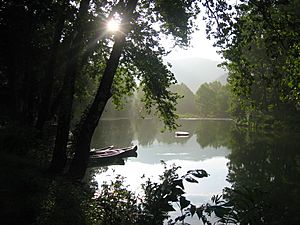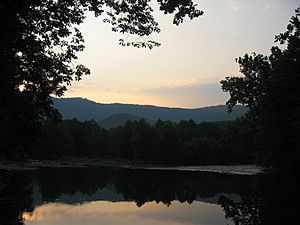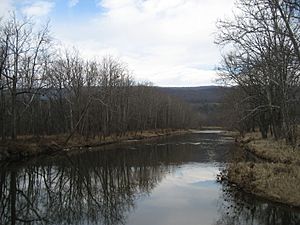Cowpasture River facts for kids
The Cowpasture River is an important river in western Virginia, United States. It flows into the famous James River. The Cowpasture River is about 84 miles (136 kilometers) long.
Contents
Where the Cowpasture River Flows
The Cowpasture River starts in the northeastern part of Highland County. It flows mostly southwest. At first, it winds through a narrow valley near the George Washington National Forest.
As it moves, smaller streams join the Cowpasture River. This makes it wider, but not very deep at first. Near Summers Mountain, the river goes through a narrow gorge. Then it opens into a wide valley in Bath County.
At a place called Williamsville, another river joins it. This is the Bullpasture River. The Bullpasture River adds a lot more water to the Cowpasture.
For about 20 miles (32 kilometers) after this, many small streams join the river. The Cowpasture River then makes wider and wider bends. After Millboro Springs, the river gets deep enough for boats all year. You can find several places to launch boats in Bath County.
Finally, in eastern Alleghany County, Simpson Creek joins the river. Soon after, the Cowpasture River enters Botetourt County. Here, it meets the Jackson River near Iron Gate. Together, they form the start of the mighty James River.
The Story Behind the River's Name
Long ago, Native Americans called this river Walatoola. This name meant "winding waters." It described how the river made many big bends. But when British settlers arrived in the 1720s, they gave it a new name: the Cowpasture River.
There's a fun story about how the Cowpasture River got its name. It also explains the names of two nearby rivers: the Bullpasture River and the Calfpasture River.
The story says that the Shawnee people once took a group of cattle from the settlers. They were trying to move the cattle westward into the mountains. The young calves got tired first. So, they were left behind at the river we now call the Calfpasture River.
The grown cows were driven further. But they also got too tired to continue. They were left in the valley of the river we now know as the Cowpasture River. The strong bulls could keep going even further west. They were finally left at the river that is now called the Bullpasture River.
The Landscape of the Cowpasture River Area
The Cowpasture River flows through a special type of landscape. This area is known as the Ridge-and-Valley Appalachians. It has many valleys and ridges. The ground here is made of different kinds of rock, like shale, limestone, and sandstone.
Because there is a lot of limestone, you can find many sinkholes and caves. Sometimes, if there hasn't been much rain, the upper parts of the river can dry up completely. When this happens, the water still flows, but it goes underground through the limestone caves instead of on the surface.
Animals Living Along the Cowpasture River
The Cowpasture River is surrounded by lots of natural areas. These include the George Washington National Forest, the Highland Wildlife Management Area, and several Wilderness Areas. This means there are many different kinds of animals living here.
You can often see bald eagles nesting along the river. These majestic birds build their homes high in the trees. River otters have also been brought back to this area. They love to play and swim in the river. Because there is so much wildlife, many hunt camps are also found along the river.




